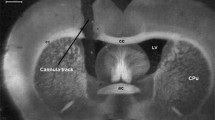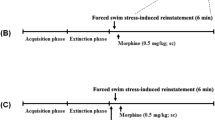Abstract
ERK pathway plays a critical role in the cellular adaptive responses to environmental changes. Stressful conditions can induce the activation of activate ERK, and its downstream targets, CREB and c-fos, in neural cells. Exposure to opioids has the same effect. In this study, we investigated the effects of morphine-induced conditioned place preference (CPP) on p-ERK/ERK ratio, p-CREB/CREB ratio and c-fos level in the mesocorticolimbic dopaminergic system including the nucleus accumbens (NAc), amygdala (AMY), striatum (Str), and prefrontal cortex (PFC).Our aim was to determine if acute and subchronic stress would affect these alterations. Male Wistar rats were divided into two saline- and morphine-treated groups. Each group contained of control, acute stress, and subchronic stress subgroups. The CPP procedure was performed for all of the rats. We dissected out the NAc, AMY, Str, and PFC regions and measured the mentioned ratios and c-fos level by Western blot analysis. The results revealed that in saline-treated animals, all factors enhanced significantly after performing acute and subchronic stress while there was an exception in p-ERK/ERK ratio in the Str and PFC; the changes were not significant during acute stress. Conditioning score decreased after applying the subchronic but not acute stress. In morphine-treated animals, all factors were increased after application of acute and subchronic stress, and conditioning scores also decreased after stress. Our findings suggest that in saline- or morphine-treated animals, acute and subchronic stress increases p-ERK, p-CREB, and c-fos levels in the mesocorticolimbic system. It has been shown that morphine induces the enhancement of the mentioned factors; on the other hand, our result demonstrates that stress can amplify these changes.




Similar content being viewed by others
References
Abel EL (1994) Behavioral and physiological effects of different water depths in the forced swim test. Physiol Behav 56:411–414
Bradford M (1976) A rapid and sensitive method for the quantitation of micro-gram quantities of protein utilizing the principle of protein-dye binding. Anal Biochem 72:248–254
Bruchas MR, Land BB, Chavkin C (2010) The dynorphin/kappa opioid system as a modulator of stress-induced and pro-addictive behaviors. Brain Res 1314:44–55
Catheline G, Le Guen S, Besson JM (1999) Effects of opioid receptor antagonists on the effects of i.v. morphine on carrageenin evoked c-Fos expression in the superficial dorsal horn of the rat spinal cord. Brain Res 824:105–111
Davis CM, Rice KC, Riley AL (2009) Opiate-agonist induced taste aversion learning in the Fischer 344 and Lewis inbred rat strains: evidence for differential mu opioid receptor activation. Pharmacol Biochem Behav 93:397–405
Daza-Losada M, Rodriguez-Arias M, Aguilar MA, Minarro J (2008) Effect of adolescent exposure to MDMA and cocaine on acquisition and reinstatement of morphine-induce CPP. Prog Neuropsychopharmacol Biol Psychiatry 32:701–709
Fanous S, Hammer RP Jr, Nikulina EM (2010) Short- and long-term effects of intermittent social defeat stress on brain-derived neurotrophic factor expression in mesocorticolimbic brain regions. Neuroscience 167:598–607
Gordon HW (2002) Early environmental stress and biological vulnerability to drug abuse. Psychoneuroendocrinology 27:115–126
Gronli J, Bramham C, Murison R, Kanhema T, Fiske E, Bjorvatn B et al (2006) Chronic mild stress inhibits BDNF protein expression and CREB activation in the dentate gyrus but not in the hippocampus proper. Pharmacol Biochem Behav 85:842–849
Guitart X, Thompson MA, Mirante CK, Greenberg ME, Nestler EJ (1992) Regulation of cyclic AMP response element-binding protein (CREB) phosphorylation by acute and chronic morphine in the rat locus coeruleus. J Neurochem 58:1168–1171
Guo Y, Wang HL, Xiang XH, Zhao Y (2009) The role of glutamate and its receptors in mesocorticolimbic dopaminergic regions in opioid addiction. Neurosci Biobehav Rev 33:864–873
Haghparast A, Taslimi Z, Ramin M, Azizi P, Khodagholi F, Hassanpour-Ezatti M (2011) Changes in phosphorylation of CREB, ERK, and c-fos induction in rat ventral tegmental area, hippocampus and prefrontal cortex after conditioned place preference induced by chemical stimulation of lateral hypothalamus. Behav Brain Res 220:112–118
Ikemoto S, Goeders NE (1998) Microinjections of dopamine agonists and cocaine elevate plasma corticosterone: dissociation effects among the ventral and dorsal striatum and medial prefrontal cortex. Brain Res 814:171–178
Imbe H, Murakami S, Okamoto K, Iwai-Liao Y, Senba E (2004) The effects of acute and chronic restraint stress on activation of ERK in the rostral ventromedial medulla and locus coeruleus. Pain 112:361–371
Johnson ZV, Revis AA, Burdick MA, Rhodes JS (2010) A similar pattern of neuronal Fos activation in 10 brain regions following exposure to reward- or aversion-associated contextual cues in mice. Physiol Behav 99:412–418
Kest K, Cruz I, Chen DH, Galaj E, Ranaldi R (2012) A food-associated CS activates c-Fos in VTA DA neurons and elicits conditioned approach. Behav Brain Res 235:150–157
Kim JA, Pollak KA, Hjelmstad GO, Fields HL (2004) A single cocaine exposure enhances both opioid reward and aversion through a ventral tegmental area-dependent mechanism. Proc Natl Acad Sci USA 101:5664–5669
Land BB, Bruchas MR, Schattauer S, Giardino WJ, Aita M, Messinger D, Hnasko TS, Palmiter RD, Chavkin C (2009) Activation of the kappa opioid receptor in the dorsal raphe nucleus mediates the aversive effects of stress and reinstates drug seeking. Proc Natl Acad Sci USA 106:19168–19173
Leao RM, Cruz FC, Marin MT, Planeta Cda S (2012) Stress induces behavioral sensitization, increases nicotine-seeking behavior and leads to a decrease of CREB in the nucleus accumbens. Pharmacol Biochem Behav 101:434–442
Lin X, Wang Q, Ji J, Yu LC (2010) Role of MEK–ERK pathway in morphine-induced conditioned place preference in ventral tegmental area of rats. J Neurosci Res 88:1595–1604
McCormick CM (2010) An animal model of social instability stress in adolescence and risk for drugs of abuse. Physiol Behav 99:194–203
Moron JA, Gullapalli S, Taylor C, Gupta A, Gomes I, Devi LA (2010) Modulation of opiate-related signaling molecules in morphine-dependent conditioned behavior: conditioned place preference to morphine induces CREB phosphorylation. Neuropsychopharmacology 35:955–966
Muschamp JW, Van’t Veer A, Parsegian A, Gallo MS, Chen M, Neve RL et al (2011) Activation of CREB in the nucleus accumbens shell produces anhedonia and resistance to extinction of fear in rats. J Neurosci 31:3095–3103
Nathaniel TI, Panksepp J, Huber R (2012) Alteration of c-Fos mRNA in the accessory lobe of crayfish is associated with a conditioned-cocaine induced reward. Neurosci Res 72:243–256
Papp M, Lappas S, Muscat R, Willner P (1992) Attenuation of place preference conditioning but not place aversion conditioning by chronic mild stress. J Psychopharmacol 6:352–356
Pascual MM, Pastor V, Bernabeu RO (2009) Nicotine-conditioned place preference induced CREB phosphorylation and Fos expression in the adult rat brain. Psychopharmacology 207:57–71
Paxinos G, Watson C (2007) The rat brain in stereotaxic coordinates, 6th edn. Elsevier, San Diego
Qi X, Lin W, Li J, Pan Y, Wang W (2006) The depressive-like behaviors are correlated with decreased phosphorylation of mitogen-activated protein kinases in rat brain following chronic forced swim stress. Behav Brain Res 175:233–240
Qi X, Lin W, Li J, Li H, Wang W, Wang D et al (2008) Fluoxetine increases the activity of the ERK–CREB signal system and alleviates the depressive-like behavior in rats exposed to chronic forced swim stress. Neurobiol Dis 31:278–285
Rittenhouse PA, Lopez-Rubalcava C, Stanwood GD, Lucki I (2002) Amplified behavioral and endocrine responses to forced swim stress in the Wistar–Kyoto rat. Psychoneuroendocrinology 27:303–318
Shaul YD, Seger R (2007) The MEK/ERK cascade: from signaling specificity to diverse functions. Biochim Biophys Acta 1773:1213–1226
Shiflett MW, Balleine BW (2011) Contributions of ERK signaling in the striatum to instrumental learning and performance. Behav Brain Res 218:240–247
Shishkina GT, Kalinina TS, Berezova IV, Bulygina VV, Dygalo NN (2010) Resistance to the development of stress-induced behavioral despair in the forced swim test associated with elevated hippocampal Bcl-xl expression. Behav Brain Res 213:218–224
Shram MJ, Funk D, Li Z, Le AD (2007) Acute nicotine enhances c-fos mRNA expression differentially in reward-related substrates of adolescent and adult rat brain. Neurosci Lett 418:286–2891
Trainor BC (2011) Stress responses and the mesolimbic dopamine system: social contexts and sex differences. Horm Behav 60:457–469
Walters CL, Cleck JN, Kuo YC, Blendy JA (2005) Mu-opioid receptor and CREB activation are required for nicotine reward. Neuron 46:933–943
Wan L, Su L, Xie Y, Liu Y, Wang Y, Wang Z (2009) Protein receptor for activated C kinase 1 is involved in morphine reward in mice. Neuroscience 161:734–742
Wang HL, Zhao Y, Xiang XH, Wang HS, Wu WR (2004) Blockade of ionotropic glutamatergic transmission in the ventral tegmental area attenuates the physical signs of morphine withdrawal in rats. Prog Neuro-Psychopharmacol Biol Psychiatry 28:1079–1087
Xu Y, Lv XF, Cui CL, Ge FF, Li YJ, Zhang HL (2012) Essential role of NR2B-containing NMDA receptor–ERK pathway in nucleus accumbens shell in morphine-associated contextual memory. Brain Res Bull 89:22–30
Yang HY, Pu XP (2009) Chronic morphine administration induces over-expression of aldolase C with reduction of CREB phosphorylation in the mouse hippocampus. Eur J Pharmacol 609:51–57
Yang CH, Huang CC, Hsu KS (2004) Behavioral stress modifies hippocampal synaptic plasticity through corticosterone-induced sustained extracellular signal-regulated kinase/mitogen-activated protein kinase activation. J Neurosci 24:11029–11034
Young KA, Gobrogge KL, Wang Z (2011) The role of mesocorticolimbic dopamine in regulating interactions between drugs of abuse and social behavior. Neurosci Biobehav Rev 35:498–515
Acknowledgments
This work was supported by the Grant (No. 91003540) from Iran National Science Foundation, Tehran, Iran.
Conflict of interest
There are no conflicts of interest.
Author information
Authors and Affiliations
Corresponding author
Electronic supplementary material
Below is the link to the electronic supplementary material.
Rights and permissions
About this article
Cite this article
Haghparast, A., Fatahi, Z., Alamdary, S.Z. et al. Changes in the Levels of p-ERK, p-CREB, and c-fos in Rat Mesocorticolimbic Dopaminergic System After Morphine-Induced Conditioned Place Preference: The Role of Acute and Subchronic Stress. Cell Mol Neurobiol 34, 277–288 (2014). https://doi.org/10.1007/s10571-013-0011-z
Received:
Accepted:
Published:
Issue Date:
DOI: https://doi.org/10.1007/s10571-013-0011-z




